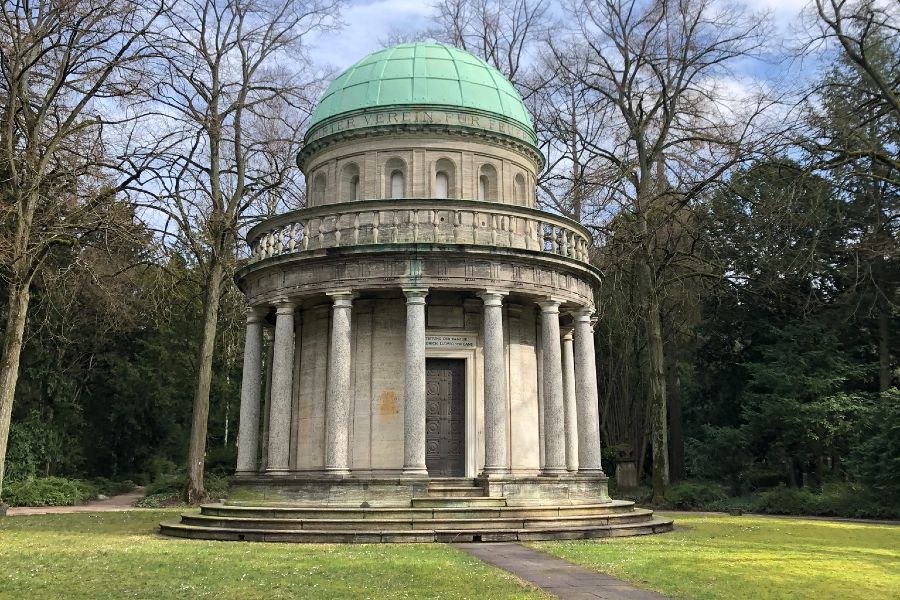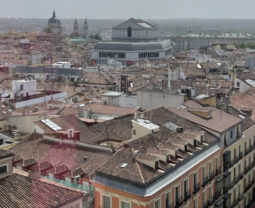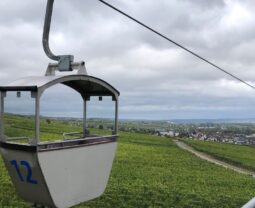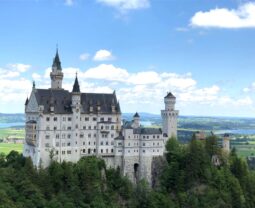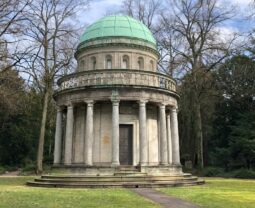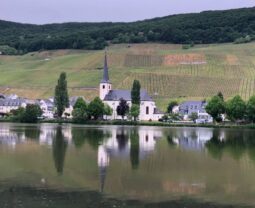I don’t normally frequent cemeteries for a “tour.” However, a friend recommended taking a Hauptfriedhof (trans: Main Cemetery) tour by the local tour company Frankfurt on Foot. Early March, just as COVID fears started creeping into Frankfurt, we looked for an activity one Sunday afternoon that felt safe in a crowd. On a beautifully warm day, we met our tour guide Jo for her very informative tour through this massive cemetery.
If you’re craving something to do during the German lockdown, the Hauptfriedhof is one of the few things still open. While it may seem a bit odd to tour the cemetery, there’s quite a lot to see and discover.
Hauptfriedhof Overview
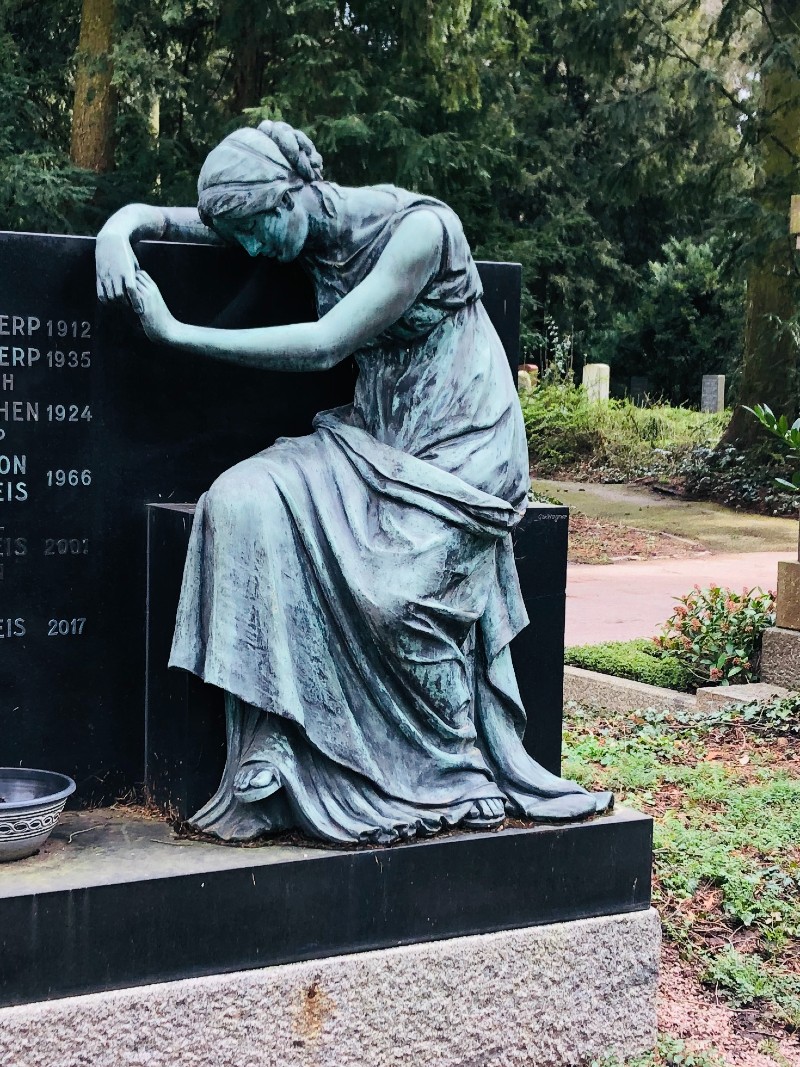
The Hauptfriedhof is located in downtown Frankfurt, across the street from the U.S. Consulate and sandwiched between the Old and New Jewish cemeteries. On a beautiful day, especially on a quiet Sunday, it’s like walking through an outdoor museum. With 8,000 graves and associated monuments, the Hauptfriedhof is one of Frankfurt’s most lavish parks, without the dogs.
Since the beginning of the 16th century, most of the city’s dead were buried in the Peterskirchhof (St. Peter’s Church cemetery) near the Zeil. After the Reformation, the Peterskirchhof was reserved only for Protestants. Jews were buried in the old Jewish cemetery in the Jewsish ghetto and Catholics were buried near the Cathedral.
For more than 300 years, St. Peter’s cemetery was carrying the load of all the deceased, and in the early 1800s, someone declared it a public health disaster. And so the Hauptfriedhof was built in 1828.
“Renting” a Burial Plot

German regulations don’t stop once Germans die. The rules even carry over into the afterlife. One of the most amusing things we noted in the cemetery was the fluorescent stickers found on gravestones and plaques letting families know the following:
- “Your plot needs maintenance.”
- “Your plot is about to come up for lease” (letting the family or others know if might be available). They even provide the date it expires.
- “Your plot is past the time allotment and needs to be re-leased”
Weirdly to Americans, in most cemeteries in Germany, you (or your family I suppose) only rent the burial plot for 20 to 30 years. And, if a family is unable or unavailable to renew the lease, the grave’s contents are “reorganized below” and the grave site reverts back to the state and may be resold or “leased.” Sometimes the headstones will be removed, but we saw a few where others were placed on the same plot.
So even when you’re resting in peace, your family still has to do your work.
Sinti and Roma Graves
Down the path from the main entrance on the left and the right are small buildings or huts that resemble garden sheds. Very ornately decorated both inside and out, they are two structures which don’t seem to fit in with the rest of the cemetery. They are, in fact, graves for Sinti/Roma (or what used to be referred to as gypsies) grave sites. These people buried here were obviously very important in their communities and a significant amount of money was spent to have these buildings constructed. The actual graves lie below the buildings.
The placement, size, and style of these memorial sites have caused quite a stir among some who feel they don’t fit in with the rest of the cemetery so there’s been some backlash over the years.
Hindenburg Memorial
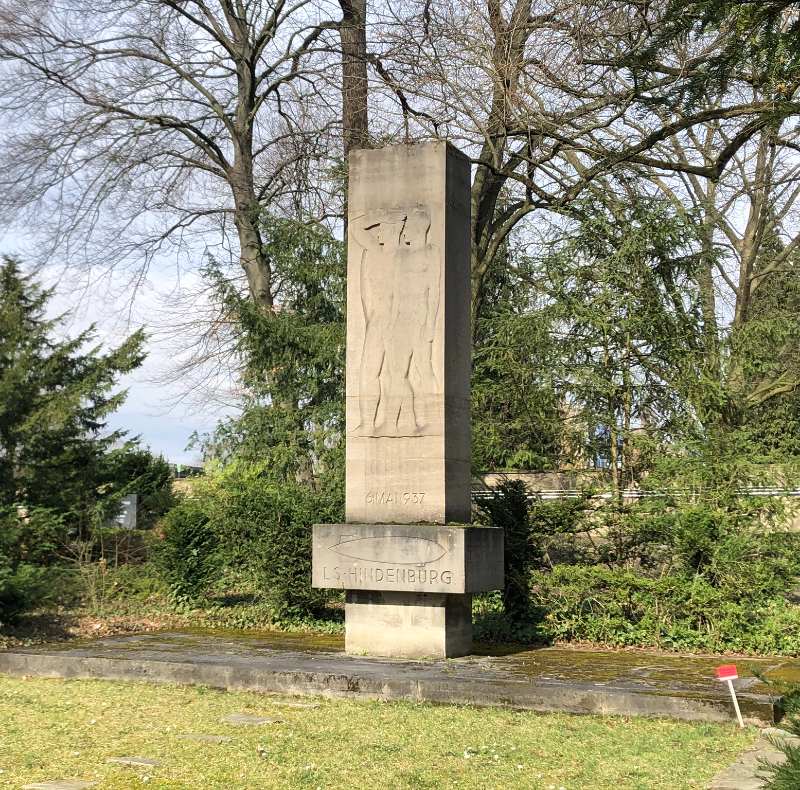
Along the perimeter of the cemetery is a column with two men and a representation of the zeppelin aircraft, which of course was built here in Germany. Seven victims of the Hindenburg crash are buried here. This Hindenburg airship crashed May 6, 1937, in New Jersey after a 77-hour flight across the Atlantic from the Rhein-Main base outside of Frankfurt. In addition to the pilots, 36 passengers and 60 crew died in the fiery crash as they were getting ready to land.
American Children’s Cemetery (Kinderfeld)

After passing the Hindenburg memorial, is a special section dedicated to the stillborn or infant children of U.S. Military families stationed in Germany after the Second World War. This area is off the path and recognizable with rows of rectangular concrete markers and American flags. Because the U.S. government didn’t pay for babies under age 2 to be flown home for burial, they needed some place to rest. Military records show from 1947 to 1951 approximately 72 babies were buried in Frankfurt.
Similar to other sections in the cemetery, graves are reused/rotated after 10 years, and the oldest grave today dates back to 1966. The last burial took place in 1986, when most U.S. military personnel left the Frankfurt area. Because the custom is these gravesites are tended by family, and those American families no longer live in Frankfurt, the area around the 177 graves needing tending from all the overgrowth. Our tour guide Jo, along with other volunteer groups, helped restore and maintain this area of the cemetery.
War Cemetery (World War 1 and 2)
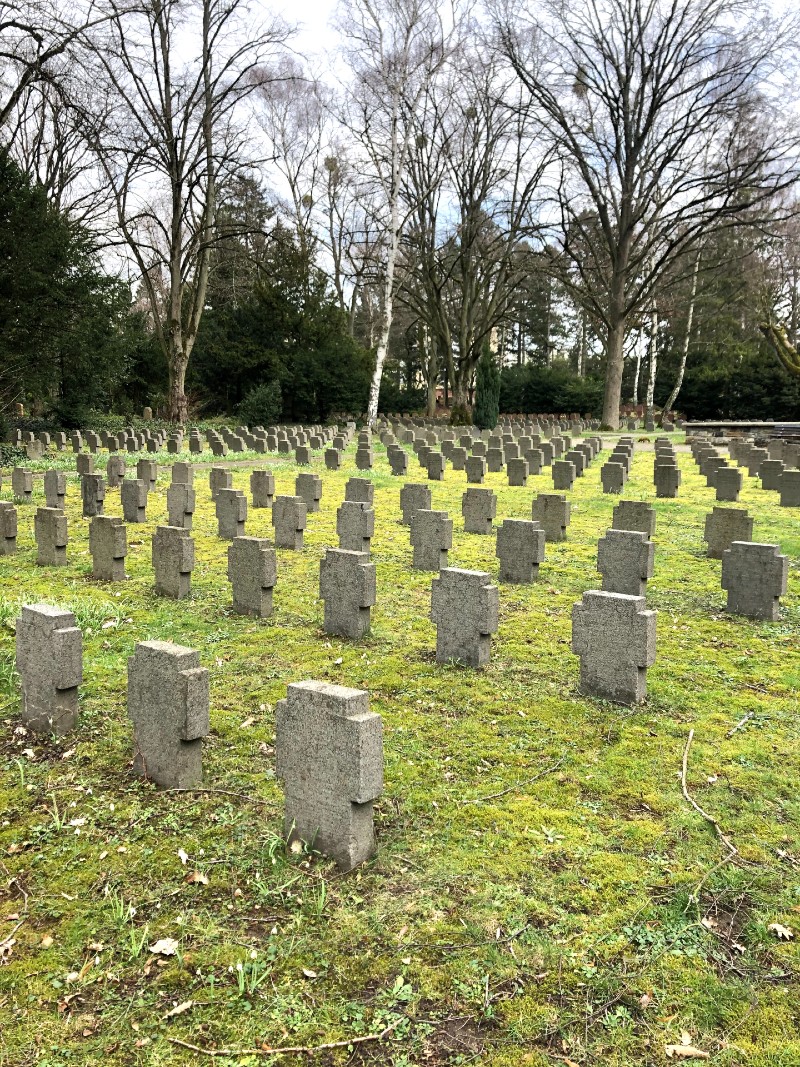

I found this section of the cemetery to be particularly interesting. If you’re looking at the map, this is in section 7. It’s easy to spot as the round war memorial sits right in the middle. Here you’ll find the gravesites for 6,700 men, women, and children from Germany, as well as other countries – who lost their lives in both World Wars, including those as victims of the Nazis. These graves do not have an expiration date and so these people able to truly rest in peace.
The area is divided into a section for World War 1 and World War 2. Most of the First World War graves were German soldiers who were wounded and taken to hospital hospitals in Frankfurt and died there, often from the Spanish flu. Others were transferred from their places of death on the front lines for burial in the main cemetery.
Around the corner from is the burial ground for victims of the Nazis. It’s simple to find this area as there’s a beautifully painful bronze statue of Job looking down at the ground. Both lying and standing tablets mark the graves for 1,4000 dead who were relocated to the cemetery after the War. That includes poisoners of concentration camps, prisons, slave labors, Soviet prisoners of war.
There is a nearby plague remembering the people with disabilities and mental illness who were murdered by the Nazis.
Mausoleums


While touring through the cemetery, we saw two mausoleums. I hear there is a third one. The first one is the Mausoleum Gans which you cannot miss as it stands in the middle of an open field. Built in 1909, step inside if it’s unlocked. The ceiling is just beautiful and decorated with stars. Walk down the steps, and you’ll see the walls lined with urns. It’s still used for burials today.
The Mausoleum Reichenbach-Lessonitz is not open to the public. This Byzantine-style building sits towards the front of the cemetery and was built for Emilie von Reichenbach-Lessonitz by her husband.
Children’s Graves
There is a lovely section of the cemetery dedicated to the tiniest children, those who were stillborn or died very young. This is different from the American Children’s Cemetery mentioned above. Four times a year, a farewell party is hosted where family members of the child may attend to remember their babies. After the celebration, the community urn is buried. The area feels different from other areas of the cemetery as it’s full of toys, candles, and flowers.
Other Highlights:
- Grave of Karl Georg Eduard Kotzenberg. This is one you cannot miss as it’s huge and smack dab in the middle of the cemetery. Whoever he was, he was important and very rich. He sits on top of a throne-like chair looking over the garden in front of him.
- Grave of Dr. Alzheimer. Yep, that’s right the Alzheimer. He has a a lovely gravesite in section J that borders the Old Jewish cemetery.
- Common grave of Polish concentration camp inmates. This area with approximately 520 urns, is in section E, ironically away from the War Cemetery, honors those who died working for the Frankfurter Adlerwerke in arms production at the SS Economic Administration Main Office.
